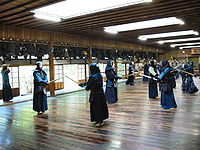
Noma dojo
Encyclopedia

Kendo
, meaning "Way of The Sword", is a modern Japanese martial art of sword-fighting based on traditional Japanese swordsmanship, or kenjutsu.Kendo is a physically and mentally challenging activity that combines strong martial arts values with sport-like physical elements.-Practitioners:Practitioners...
training hall, or dojo
Dojo
A is a Japanese term which literally means "place of the way". Initially, dōjōs were adjunct to temples. The term can refer to a formal training place for any of the Japanese do arts but typically it is considered the formal gathering place for students of any Japanese martial arts style to...
, located in Tokyo
Tokyo
, ; officially , is one of the 47 prefectures of Japan. Tokyo is the capital of Japan, the center of the Greater Tokyo Area, and the largest metropolitan area of Japan. It is the seat of the Japanese government and the Imperial Palace, and the home of the Japanese Imperial Family...
's Bunkyo ward close to Gokoku-ji
Gokoku-ji
is a Shingon Buddhist temple in Tokyo's Bunkyō.-History:This Buddhist temple was established by the fifth shogun Tokugawa, Tsunayoshi, who dedicated it to his mother...
. The original Noma Dojo was established in 1925 by Seiji Noma, founder of the Kodansha
Kodansha
, the largest Japanese publisher, produces the manga magazines Nakayoshi, Afternoon, Evening, and Weekly Shonen Magazine, as well as more literary magazines such as Gunzō, Shūkan Gendai, and the Japanese dictionary Nihongo Daijiten. The company has its headquarters in Bunkyō, Tokyo...
publishing house, but demolished by the company in late 2007 and replaced with a modern training hall in a neighbouring office building.
The original hall had long been one of the most celebrated kendo dōjō in Japan
Japan
Japan is an island nation in East Asia. Located in the Pacific Ocean, it lies to the east of the Sea of Japan, China, North Korea, South Korea and Russia, stretching from the Sea of Okhotsk in the north to the East China Sea and Taiwan in the south...
. Core elements of the building dated from an Edo period
Edo period
The , or , is a division of Japanese history which was ruled by the shoguns of the Tokugawa family, running from 1603 to 1868. The political entity of this period was the Tokugawa shogunate....
dōjō previously located at a different site. It was the only example of its type to survive into the 21st century and has been described by Japanese media as a "holy place" for kendo enthusiasts.
The hall had a number of unusual design features, including glass-doored walls on two sides that open onto gardens, deep skylights and a specially sprung wooden floor. The long and relatively narrow shape of the hall meant it was ideal for kendo practices involving a single row of paired-off fencers.
In an article in Japan's Nihon Keizai Shimbun
Nihon Keizai Shimbun
is one of the largest media corporations in Japan. Nikkei specializes in publishing financial, business and industry news. Its main news publications include:* Nihon Keizai Shimbun , a leading economic newspaper....
published on September 15, 2006, former Kodansha chairman Toshiyuki Hattori wrote that the publishing house had decided to demolish Noma Dojo as part of a redevelopment of the company compound. Hattori appealed for the company to reconsider its plans, saying the dōjō was a place where the "fragrant, darkly lustrous wood" was "permeated with the blood and sweat of famous fencers". Architects, conservationists and some public figures also called for the hall to be preserved or at least moved to a new site.
However, by October 2007, Kodansha had completed the demolition of a nearby early-20th aristocratic villa and the construction on the site of a new office building with a fifth-floor dōjō. Late appeals for the Noma Dojo hall to be preserved by moving it to Seiji Noma's hometown resulted only in agreement to transfer its porch. The rest of the building was razed by early December.
Apart from its architectural value, Noma Dōjō has been celebrated for the excellence of its teachers, including the late Moriji Mochida, a holder of the 10th Dan rank
Dan rank
The ranking system is a Japanese mark of level, which is used in modern fine arts and martial arts. Originally invented in a Go school in the Edo period, this system was applied to martial arts by Kanō Jigorō, the founder of judo and later introduced to other East Asia countries.In the modern...
who was known as a "master swordsman of the Shōwa period
Showa period
The , or Shōwa era, is the period of Japanese history corresponding to the reign of the Shōwa Emperor, Hirohito, from December 25, 1926 through January 7, 1989.The Shōwa period was longer than the reign of any previous Japanese emperor...
". As well as being used by the Kodansha kendo club, the hall has for decades held a daily 7 a.m. practice that is open to kendo fencers from any school or association.
Kodansha has said the morning practice will continue in the new dōjō, which was designed to reflect some of the features of the old hall, including the use of skylights.
External links
- "'Sacred' kendo dojo tries to parry dismantling plans" Daily Yomiuri Online
- A Short History of The Noma Dojo by Masafusa Mochizuki
- Photo blog by Noma Dojo member recording efforts to save the building and its eventual demolition
- Noma Dojo homepage
- Account of visit to Noma Dojo

